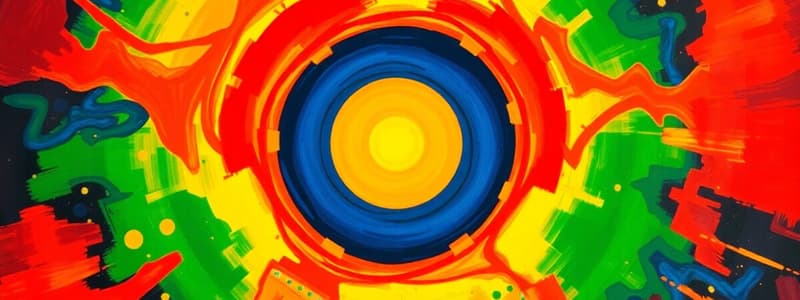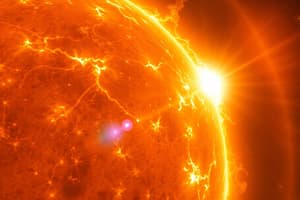Podcast
Questions and Answers
Which layer of the Sun is responsible for the generation of solar energy through nuclear fusion?
Which layer of the Sun is responsible for the generation of solar energy through nuclear fusion?
- Photosphere
- Radiative Zone
- Core (correct)
- Convection Zone
What is the main characteristic of the Convection Zone in the Sun?
What is the main characteristic of the Convection Zone in the Sun?
- It has the highest temperature in the Sun.
- It contains the majority of the Sun's mass.
- It is the outermost layer of the Sun.
- Energy is transported by the movement of hot plasma. (correct)
Which layer of the Sun is visible during a total solar eclipse?
Which layer of the Sun is visible during a total solar eclipse?
- Radiative Zone
- Photosphere
- Chromosphere (correct)
- Core
What defines sunspots on the surface of the Sun?
What defines sunspots on the surface of the Sun?
Which sun layer has a temperature that increases significantly with distance from the surface?
Which sun layer has a temperature that increases significantly with distance from the surface?
What describes the Sun's spin rate 4.6 million years ago compared to now?
What describes the Sun's spin rate 4.6 million years ago compared to now?
Which statement accurately describes the young Sun's wind conditions compared to now?
Which statement accurately describes the young Sun's wind conditions compared to now?
What is the primary component of the Sun's core composition now?
What is the primary component of the Sun's core composition now?
During the young Sun's period, how did the frequency of solar flares compare to the present?
During the young Sun's period, how did the frequency of solar flares compare to the present?
How did the activity of sunspots change from 4.6 million years ago to now?
How did the activity of sunspots change from 4.6 million years ago to now?
Which of the following planets is classified as a terrestrial planet?
Which of the following planets is classified as a terrestrial planet?
What phenomenon occurs during the June Solstice in the Northern Hemisphere?
What phenomenon occurs during the June Solstice in the Northern Hemisphere?
Which of the following lunar phases occurs after the New Moon phase?
Which of the following lunar phases occurs after the New Moon phase?
What is a key characteristic of jovian planets compared to terrestrial planets?
What is a key characteristic of jovian planets compared to terrestrial planets?
What is the correct order of lunar phases starting from New Moon to Full Moon?
What is the correct order of lunar phases starting from New Moon to Full Moon?
What is the primary reason for the changing seasons on Earth?
What is the primary reason for the changing seasons on Earth?
Which lunar phase occurs approximately one week after the New Moon?
Which lunar phase occurs approximately one week after the New Moon?
During which equinox does day and night have approximately equal lengths?
During which equinox does day and night have approximately equal lengths?
What type of eclipse occurs when the Earth comes between the sun and the moon?
What type of eclipse occurs when the Earth comes between the sun and the moon?
Which of the following moons would be in the waning phase after a full moon?
Which of the following moons would be in the waning phase after a full moon?
Which planet has a well-defined ring system?
Which planet has a well-defined ring system?
What is the phenomenon called when the moon passes directly between the Earth and the sun?
What is the phenomenon called when the moon passes directly between the Earth and the sun?
Which of the following best describes a waxing phase of the moon?
Which of the following best describes a waxing phase of the moon?
What is a key characteristic that differentiates Jovian planets from terrestrial planets?
What is a key characteristic that differentiates Jovian planets from terrestrial planets?
Which of the following statements about the atmospheres of terrestrial and Jovian planets is true?
Which of the following statements about the atmospheres of terrestrial and Jovian planets is true?
What distinguishes the rotational speed of Jovian planets compared to terrestrial planets?
What distinguishes the rotational speed of Jovian planets compared to terrestrial planets?
Which planetary group is characterized by having multiple moons?
Which planetary group is characterized by having multiple moons?
Which of the following correctly represents a feature of terrestrial planets?
Which of the following correctly represents a feature of terrestrial planets?
What type of planetary bodies are noted for spinning quickly and having all their members with rings?
What type of planetary bodies are noted for spinning quickly and having all their members with rings?
Which characteristic is NOT true for Jovian planets?
Which characteristic is NOT true for Jovian planets?
What material predominates in terrestrial planets?
What material predominates in terrestrial planets?
What is a potential benefit of using the Doppler Method in research?
What is a potential benefit of using the Doppler Method in research?
Which of the following could be considered a drawback of the Doppler Method?
Which of the following could be considered a drawback of the Doppler Method?
What does SETI primarily focus on?
What does SETI primarily focus on?
Which of the following attributes can be considered a weakness in current extraterrestrial communication methods?
Which of the following attributes can be considered a weakness in current extraterrestrial communication methods?
Which strength is often cited when discussing techniques used in SETI's initiatives?
Which strength is often cited when discussing techniques used in SETI's initiatives?
What typically influences the geological features of planets in the solar system?
What typically influences the geological features of planets in the solar system?
Which component is NOT commonly found in the atmospheres of terrestrial planets?
Which component is NOT commonly found in the atmospheres of terrestrial planets?
What primarily distinguishes Jovian planets from terrestrial planets?
What primarily distinguishes Jovian planets from terrestrial planets?
Which of the following is a characteristic of craters on planetary surfaces?
Which of the following is a characteristic of craters on planetary surfaces?
What is the primary reason for the variation in surface temperatures among terrestrial planets?
What is the primary reason for the variation in surface temperatures among terrestrial planets?
Which feature is often associated with volcanic activity on planets?
Which feature is often associated with volcanic activity on planets?
What typically characterizes the atmospheres of Jovian planets?
What typically characterizes the atmospheres of Jovian planets?
In what way does carbon dating help scientists?
In what way does carbon dating help scientists?
Which factor has the least impact on the geological evolution of a planet?
Which factor has the least impact on the geological evolution of a planet?
What might indicate a history of erosion on a planetary surface?
What might indicate a history of erosion on a planetary surface?
Which Jovian moon is known for its thick atmosphere and potential for liquid water beneath its surface?
Which Jovian moon is known for its thick atmosphere and potential for liquid water beneath its surface?
Which ranking describes the order of the main terrestrial planets from closest to farthest from the Sun?
Which ranking describes the order of the main terrestrial planets from closest to farthest from the Sun?
What primarily drives the atmospheric dynamics of gas giants?
What primarily drives the atmospheric dynamics of gas giants?
Which process contributes significantly to the shaping of planetary surfaces over geological time?
Which process contributes significantly to the shaping of planetary surfaces over geological time?
Flashcards
Sun's Layers
Sun's Layers
The Sun is made of different layers, each with unique properties.
Core of the Sun
Core of the Sun
The central part of the Sun where nuclear fusion occurs.
Photosphere
Photosphere
The visible surface of the Sun, where light is emitted.
Convection Zone
Convection Zone
Signup and view all the flashcards
Sunspots
Sunspots
Signup and view all the flashcards
Terrestrial Planets
Terrestrial Planets
Signup and view all the flashcards
Jovian Planets
Jovian Planets
Signup and view all the flashcards
Mercury
Mercury
Signup and view all the flashcards
Venus
Venus
Signup and view all the flashcards
Earth
Earth
Signup and view all the flashcards
Mars
Mars
Signup and view all the flashcards
Jupiter
Jupiter
Signup and view all the flashcards
Saturn
Saturn
Signup and view all the flashcards
Uranus
Uranus
Signup and view all the flashcards
Neptune
Neptune
Signup and view all the flashcards
Summer Solstice
Summer Solstice
Signup and view all the flashcards
Winter Solstice
Winter Solstice
Signup and view all the flashcards
Full Moon
Full Moon
Signup and view all the flashcards
Lunar Phases
Lunar Phases
Signup and view all the flashcards
Blackbody Radiation
Blackbody Radiation
Signup and view all the flashcards
What is the Doppler Effect?
What is the Doppler Effect?
Signup and view all the flashcards
Spectroscopy
Spectroscopy
Signup and view all the flashcards
Interstellar Medium
Interstellar Medium
Signup and view all the flashcards
Nebular Hypothesis
Nebular Hypothesis
Signup and view all the flashcards
Doppler Method
Doppler Method
Signup and view all the flashcards
Radial Velocity
Radial Velocity
Signup and view all the flashcards
Transit Method
Transit Method
Signup and view all the flashcards
SETI
SETI
Signup and view all the flashcards
What is the goal of SETI?
What is the goal of SETI?
Signup and view all the flashcards
Jovian Planet Composition
Jovian Planet Composition
Signup and view all the flashcards
Jovian Planet Structure
Jovian Planet Structure
Signup and view all the flashcards
Jovian Planet Mass
Jovian Planet Mass
Signup and view all the flashcards
Jovian Planet Rotation
Jovian Planet Rotation
Signup and view all the flashcards
Jovian Planets and Rings
Jovian Planets and Rings
Signup and view all the flashcards
Jovian Planets and Moons
Jovian Planets and Moons
Signup and view all the flashcards
Fly-by Mission
Fly-by Mission
Signup and view all the flashcards
Orbiter Mission
Orbiter Mission
Signup and view all the flashcards
Frost Line
Frost Line
Signup and view all the flashcards
Planetary Differentiation
Planetary Differentiation
Signup and view all the flashcards
Planetary Core
Planetary Core
Signup and view all the flashcards
Planetary Mantle
Planetary Mantle
Signup and view all the flashcards
Planetary Crust
Planetary Crust
Signup and view all the flashcards
Planetary Heating
Planetary Heating
Signup and view all the flashcards
Planetary Cooling
Planetary Cooling
Signup and view all the flashcards
Impact Crater
Impact Crater
Signup and view all the flashcards
Volcano
Volcano
Signup and view all the flashcards
Volcanism
Volcanism
Signup and view all the flashcards
Plate Tectonics
Plate Tectonics
Signup and view all the flashcards
Erosion
Erosion
Signup and view all the flashcards
Atmosphere
Atmosphere
Signup and view all the flashcards
Study Notes
General
- No specific topic provided. Please provide text or questions for me to summarize.
Studying That Suits You
Use AI to generate personalized quizzes and flashcards to suit your learning preferences.




